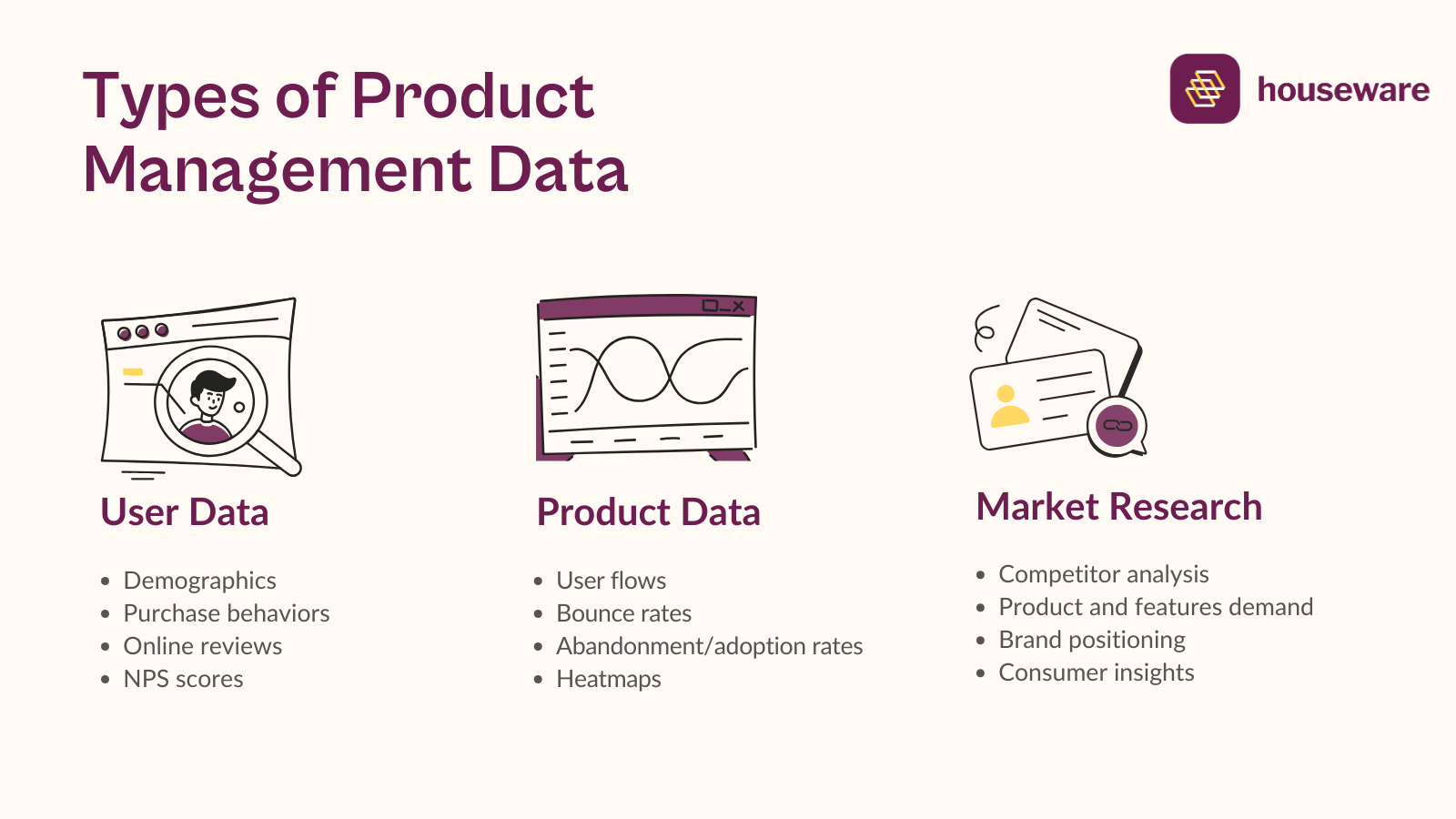A Deep Dive into Data-Driven Product Strategy

If you're a product manager, these conversations might sound familiar:
You: "We need to add a feature."
Stakeholder: "Why do you think that? Do you have data to support it?"
You: "This is a top request from our current customers. I strongly believe we should add this to our roadmap. Creating this feature could significantly increase our revenue."
Stakeholder: "What data do you have to support this?"
For product management, data is essential. Using a data-driven product strategy, product managers can identify user needs, prioritize features, and make informed decisions to achieve product-led growth.
This article will explore a data-driven product strategy framework, its advantages for product teams, and how to create one.
What is a Data-Driven Product Strategy?
A data-driven product strategy is a product development and management approach that relies on product analytics to inform decision-making and guide product direction. With a comprehensive understanding of product usage, a data-driven product strategy takes your product strategy to the next level.
Product managers employ a variety of methods to master product growth. A data-driven framework, rather than guessing what needs to be done next, assists you in making the "right" decisions on:
- How you'll meet customer needs;
- Reach business goals and
- Provide unique value
Types of Product Management Data
Many types of data points inform your product strategy. Both qualitative and quantitative data make their way for PMs to gain a comprehensive view of their users and make informed decisions. We can categorize them together roughly into the following categories:
1. User data
You must understand your customers to serve them and build a product they love. Leveraging user data helps you stay user-focused and ensures you're designing the right Product at the right time.
Here are different types of user data:
- Demographics
- Purchase behaviors
- Online reviews
- NPS scores
2. Product data
As much as you should know about your users, you should also have to know what's happening inside your Product. Whether you have an app, software, or website, you need to know the nuances of your Product, like the typical user flows, onboarding process, feature adoption, and other product metrics.
Here are different types of product data to keep track of:
- User flows
- Bounce rates
- Abandonment/adoption rates
- Heatmaps
3. Market Research
If you're launching a new product, it's critical to understand the environment in which your Product is expected to thrive. You need to incorporate the market since the ideation.
Different types of market research to incorporate into your product strategy are:
- Competitor analysis
- Product and features demand
- Brand positioning
- Consumer insights

Why Leverage Data to Drive Product Growth?
21% of products fail to meet customers' needs. One primary reason for this failure is the need for more insights into customers' problems and how your Product can solve these problems. Data is at the core of effective product management.
Only spend some time and effort creating the templates and perfecting the documents. Answering key product questions is more critical.
– Brian Lawley
Product management data analytics help PMs in the below different ways:
1. Guide product strategy
Your product strategy framework outlines your objectives and how you plan to achieve them. Identifying key customer and business metrics helps you track progress against your goals. Customer-oriented metrics are significant leading indicators and provide rapid feedback on the impact of your product actions. Business-oriented metrics provide a more lagging view of progress toward your goals. Product managers can leverage these metrics and the supporting data to create a product roadmap.
2. UI and UX decisions
Product analytics data helps you understand how users interact with your Product's interface. By analyzing user journeys, heatmaps, and user feedback, you can make data-driven decisions about UI and UX improvements. This ensures that the product design aligns with user expectations and enhances the overall user experience.
3. Features
Product management is a continuous and iterative process. PMs often need to decide which features to prioritize or develop. They can rely on the insights from their product analytics software to assess the impact of existing features and user demand. Analyzing feature adoption rates, user feedback, and performance metrics helps PMs decide which features will provide the most value to users.
4. Marketing efforts
Data analytics is crucial in measuring the effectiveness of marketing campaigns. You can track conversion rates, user acquisition, and other important metrics to evaluate the success of your marketing efforts. This information can help marketing teams optimize strategies, allocate resources efficiently, and focus on the channels that deliver the best results.
"Good companies manage Engineering. Great companies manage Products."
– Thomas Schranz
Creating a Data-Driven Product Strategy: Checklist
1. Gather data
Data lays the foundation of a product strategy framework. The very first thing to do is gather data from different sources. You can leverage warehouse-native product analytics tools like Houseware that seamlessly connect with your data warehouse to collect user feedback, customer support tickets, and more.
2. Identify trends
The next step in creating a data-driven product strategy is identifying patterns and trends that inform product development. Cutting-edge product analytics tools like Houseware use predictive modelling, AI and machine learning algorithms, deep learning, and other statistical methods to analyze data and provide granular insights.
Its Trends feature analyzes metrics and compositions within your event data using line charts or table views. These powerful visualizations help you analyze key product metrics, like the number of users performing a particular event, the number of different countries users are logging in from, the composition of these metrics, and more.
3. Analyze customer behavior
Analyzing customer behaviour involves examining customer-oriented data. This helps to understand how they interact with your Product, which features they use, and how they make purchasing decisions. By knowing how customers behave with your Product, you can better understand their requirements and predict what they want. This, in turn, helps you make informed decisions about the Product's strategy, design, and marketing.
4. Identify common pain points.
Next, you need to identify areas of improvement by identifying user pain points. Leverage flow charts to identify patterns or issues that users frequently encounter. Flow charts offer a visual narrative, revealing the routes users often use and unveiling their sequential interaction with your Product. You can analyze the drop-offs or any unsuccessful behaviour to identify bottlenecks.
For instance, say your eCommerce store experiences a high cart abandonment rate. Rather than assuming customers lack interest in your products, delve into the data for a more in-depth understanding. Analyze user journeys to study users' steps from product selection to checkout. Evaluate the ease of completing a purchase by analyzing the entire checkout process, including form simplicity and payment options. Also, investigate if any unexpected costs at the checkout contribute to abandoned carts.
5. Develop your strategy's KPIs
As you create your strategy, make sure to develop measurable KPIs. This will help you determine if your product strategy is based on correct assumptions. If you find out early on that your initial assumptions were wrong, it will allow your team to correct course sooner, which means less time and resources wasted on the wrong path.
When creating your KPIs, there are two categories of metrics that you should focus on:
The North Star Metric is an important metric that should guide your product team's efforts. It Should represent the connection between the customer problems your team is trying to solve and the revenue your business aims to generate by solving those problems.
Input metrics are actions your users take that indicate success and help drive your output metrics. For instance, for an eCommerce store, input metrics could include the average number of products viewed per session or the in-app search rate.
6. Document your product strategy framework.
A data-driven product strategy framework should outline every theme, epic, and other product initiatives that should earn a spot on the roadmap. Future product functionality and feature release dates provide crucial context for design and development teams when documented. Your strategy aligns the design and development efforts with broader product and company goals, providing a strategic vision for all stakeholders.

How to Get Started?
Creating a data-driven product strategy is easy with Houseware. Our warehouse-native product analytics platform lets you start without complex or expensive data transfers. Our robust and intuitive visualizations guide you every step of the way, helping you understand more about your user journeys and make data-driven, informed decisions.
Schedule a demo with our team today to discover how to combine data and intuition to build a more efficient and successful product.
FAQs
1. How do you become a data-driven product manager?
A product manager should be able to analyze and interpret data to become data-driven and integrate data into various aspects of product management.










